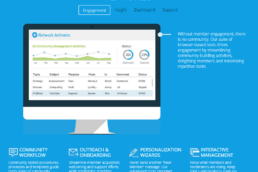I am giving a webinar today on the difference between B2B and B2C online community for The Advisory Counsel. While online communities have been around for quite some time (think ARPAnet) they have recently been gaining quite a bit of media attention. But the problem with the information being discussed is that it often doesn’t differentiate between the different types of communities and there are big differences between consumer and business models. While both seek to influence brand – consumer communities are intended to project or influence outwardly with the focus being on influencer markets and brand evangelism. Meanwhile, business to business communities are more focused on bringing the clients and the company closer together in partnership. Technical support communities fall somewhere in between the two models.
Consumer communities are typically large in number because they most often have a revenue model that is ad supported. Scale is essential to financial success. The more eyes that are on an ad the better. When successful, they are quick to scale but members tend to have weak ties between them. Sure, there are some core members who are always present in the forums or on the community, but the majority of users collaborate and evaporate. There are few predictable and reliable user relationships over time.
With B2B communities, membership matters more. They are often gated or have authenticated user acceptance policies. BusinessWeek recently did a nice article showcasing elite or private communities for doctors, mobile executives and a few others. Because a membership threshold exists – a member must be a client, or a specific kind of professional or persona – there tends to be fewer members but the relationships between members and the organization are stronger because they are engaging over time. The members also tend to know each other IRL (in real life) so there are greater dependencies among the group.
This is just the most apparent difference – tools, content needs, interaction design all offer important differences that are not interchangeable when creating professional communities.
Related Posts
July 10, 2018
How To Increase User Engagement in your Online Community
Every member goes through four stages of activity within an online community:…
October 26, 2015
Online Community Managers: A Tool of Our Own!
For years, social media marketers have had tools like Hootsuite, Sprinklr, and…
October 15, 2015
Announcing: Online Community Readiness and Growth Research Study
A new study to find the keys to community readiness and growth


